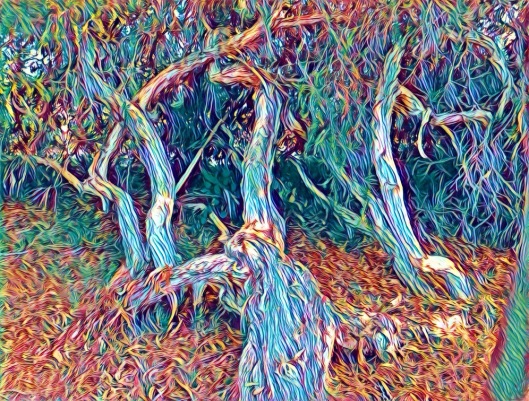
This post is an extension to the Pattern — Small Successes Early — and trials the addition of two more sections to the traditional form of a Pattern: Metaphor and Fable.
Metaphor:
(This section is a departure from the traditional form of Patterns. It’s intent is to show how the same general principles that are embodied in the pattern also apply in other domains).
Life on earth, according to current estimates, has been around for 4.75 billion years. Evolution has had a long time to “learn” effective ways to do things. Have you ever seen an oak tree decide to migrate to a new place in the forest? Have you noticed it getting grumpy and yanking itself up by the roots and walking 30 meters to richer soil or closer to a stream and stabbing its roots back into the dirt in order to settle in its new place? (I mean apart from Tolkien’s Ents?) No, and neither have I. What does an oak tree do? It puts some energy into making acorns. Each acorn costs the tree (a tiny bit) in terms of water, soil nutrients, and sugar that it made from photosynthesis in its leaves. But it does not bet the farm on a better place. Some acorns will be scattered by squirrels onto new and better ground. If the conditions are just right the acorn will germinate and send up a small shoot and send down a primary root. Over time that acorn may grow into a mighty oak. Small successes early. Similar strategies are taken by other plants whether they propagate by runners, by seeds, or by spores. Animals typically also “start small.”
What can we learn from human practices that have evolved over millennia? For example, people have been building things for a long time. What are the practices around making a new building? People don’t just dig into a huge building project. They draw up plans; they discuss it; they typically build small scale models. If they see no problems with these models, they begin construction on the real thing. We think of these plans and models as being ways to coordinate the work and so they are. But they also serve a critical social purpose. Various stakeholders can look at the plans and models and question various decisions before there is a huge sunk cost.

What do people do when they want to put on a stage play? They don’t typically write a play and then immediately spend a huge amount of money advertising it, building scenery, making costumes and then sell tickets for the Broadway opening. No. People write a play and then do a “reading” with a small group of people. Many issues get ironed out. Eventually, people may cast the play and have people rehearse. Again, they need not do this with full costumes, make-up, and scenery. Instead, they “work out the kinks” in the play, occasionally changing lines, but very often changing the manner in which lines are said. In later stages, the blocking or lighting may change. Eventually, people have what are called “dress rehearsals” to make sure everything is working right. The producers want to insure that the scenery doesn’t fall down; that the costumes don’t rip; that people know their lines. In many cases, people open off-Broadway to give them a further chance for improvement before a Broadway opening with its potential for roasting by drama critics.
One of the longest running continuous institutions is the Catholic Church. Would you like to be elected Pope? Good luck with that. The Pope isn’t chosen by an open lottery or elected by the general populace who pick anyone they like. If you want to be Pope, you have to first pass through all sorts of “tests” to prove yourself as a Catholic; then, prove yourself as a Priest; after a long successful career, you may be eventually become a Bishop. Many professions that have had a long history developed similar though perhaps less elaborate hierarchies based on expertise and experience. They start with small successes. If you can handle lower level duties successfully, you move up the hierarchy from apprentice, to journeyman to master.
So, when it comes to biology, which has had billions of years of evolution, the tendency is overwhelmingly to use “Small Successes Early” and when it comes to human cultural evolution of roles and large scale processes that have been around for thousands of years, people use “Small Successes Early.” It is only some modern business managers who feel there is no need for such prudence because, after all, they are smart enough to foresee all consequences and therefore have no need for “Small Successes Early.”
Fable:
(This section is another addition and departure from the form of a typical Pattern. It tries to encapsulate the basic idea of the Pattern into a fable similar to those of Aesop).

Rarin’ Rabbit hated the farmers who kept chasing him and his brethren from the gardens. The whole hutch spent as much energy going from their warren to the garden and getting chased back as they did from the occasional tasty morsel they managed to steal.
One bright day, Rarin’ Rabbit happened upon a dry creek bed filled with clover, purslane, and plantain. He immediately went back to the warren and convinced all his fellow rabbits to move their warren into the sides of the dry creek bed. Now, all they had to do for a great meal was step outside their front door! No farmers chasing them! It really did seem as though Rarin’ Rabbit had led his entire tribe to the promised land!
Rarin’ Rabbit grew immensely popular. One hot and humid day in late summer, Rarin’ Rabbit and his compatriots were munching on some wild roses that grew on the sides of the arroyo when they heard thunder in the distant hills. Some of the rabbits got nervous and began wondering if the rain drops would come down on them. Some suggested perhaps that it was prudent to stop snacking and head back to the shelter of their warren. “Nonsense!” Rarin’ Rabbit protested. “There’s no rain here! Let’s keep eating till we’re as big as elephants! You have to dream greatly if you want to succeed greatly!” Most of the rabbits stayed for Rarin’ Rabbit was indeed quite popular — right up until the flash flood came hurtling down the canyon sweeping away Rarin’ Rabbit, all his companions, and the rabbit warren. Every last one drowned.

The moral of the story is: “Dream greatly. But test out your great dreams by first trying to find small successes early.”

Good advice and metaphors!
I’m afraid that you’re reaching with this one. That’s not how evolution works, natural or cultural. The principle behind it is natural selection. It is only a success in retrospect 1,000s or millions of years, later. The “innovation” is actually an error, and the VAST majority of these innovations lead to immediate death.
The lesson there is. Fail early at great cost, very slim chance that you might get lucky after, say, a million trials.
Interesting. I’ll have to give that some further thought. A few things now though. 1) Kind of beside the point, but evolution has some pretty cool mechanisms that are more sophisticated than natural selection; e.g., crossover, sexual selection, intra-chromosomal duplication;. 2) More complex organisms have a lot of mechanisms to prevent one mutation in a cell to cause immediate death. 3) Even apart from that, not every (or nearly every) attempted “innovation” in biology is a deadly error. In the case of humans, as I understand it, almost every chromosome has one or more cross-over points. We have two parents. So, every child, even absent any mutations is a new combination. (There are no “identical twins” born years apart). Half the genes (roughly) come from each parent. So, in the parents, the combination that they had was not lethal. But that doesn’t guarantee that any given particular new combination won’t be. To some extent, there is already a “culling” in the sperm cells. If they are not “fit” in motility, e.g., they are very unlikely to be the one to fertilize. So this seems to me to be yet another example of something similar to “Small Successes Early” — or maybe better, “Don’t put all your eggs in one basket.” From the perspective of the sperm cell, it’s a BIG DEAL — and indeed, a single mutation or simply a bad combination of genes could result in its lack of further life. But from the perspective of the two adults, having these “experimental” recombinations is a small price compared, for instance, with the time and effort they will typically put into trying to make sure their offspring lives long enough to again reproduce. Humans though are at the very high end of a scale in terms of living things; most really spawn huge numbers of potential offspring and put relatively little effort into each one while whales, and people, and elephants have far fewer offspring but put a lot of effort into each one. Maybe the idea of metaphor with animal and plant strategies is ill-conceived though. One of the reasons “Small Successes Early” can be effective for projects is because of the psychology of the participants. Any way, thanks for the thought provoking comments.
Pingback: Pattern Language Summary | petersironwood